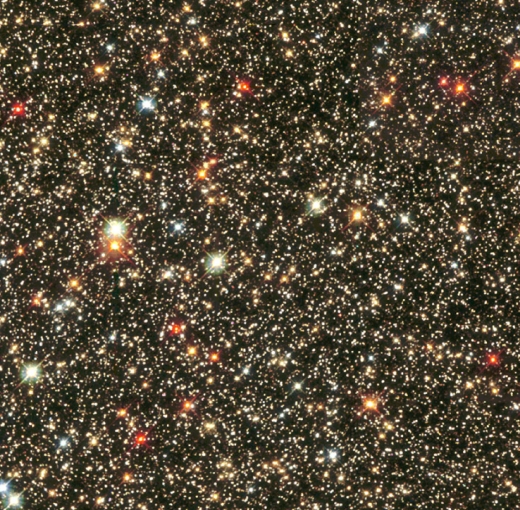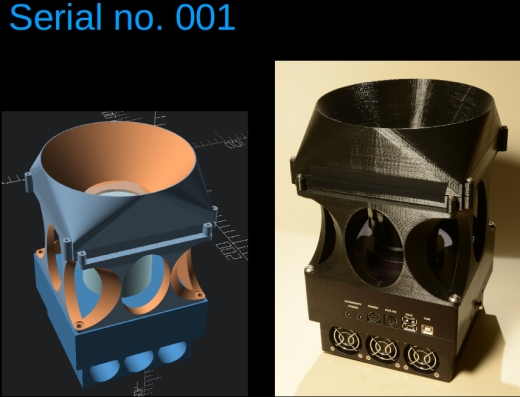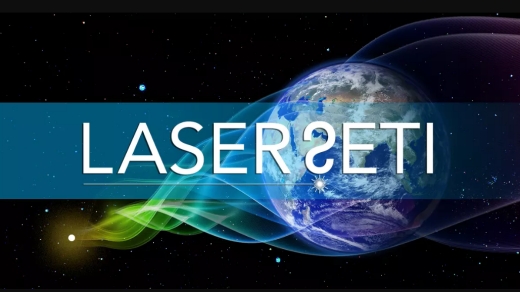The SETI Institute’s just announced Laser SETI funding campaign intends to put into practice what SETI researchers have been anticipating for decades, an all-sky, all-the-time observing campaign. The Institute’s Eliot Gillum and Gerry Harp are behind the project, backed by an impressive list of advisors, with the intention of using optical SETI methods to look for signs of extraterrestrial civilizations. In doing so, they’re reminding us how we’ve done SETI, how we can surmount its current limitations, and what a SETI of the future will look like.
Think about how SETI has evolved since the days when Frank Drake created Project Ozma at the National Radio Astronomy Observatory at Green Bank (WV). Fresh with the insights of Giuseppe Cocconi and Philip Morrison, who examined radio methods and suggested a search for signals near the 21 centimeter wavelength of neutral hydrogen, Drake turned a 26-meter radio telescope to examine the nearby Sun-like stars Tau Ceti and Epsilon Eridani.
Would SETI be a matter of looking at specific stars at certain wavelengths? Immediately the list of questions began to grow. Once you have chosen a target (and there are 18 million stars within 1000 light years), how long do you need to examine it before moving on to another? For that matter, are radio wavelengths optimal? And if our method is to look at particular places at particular times, how would we detect periodic signals that are on no schedule we can hope to predict? What do we miss in between?

Image: The view toward Messier 24, the Sagittarius star cloud. We are looking for signals amidst immensity. Credit: Hubble Heritage Team (AURA/ STScI/ NASA).
All Sky All the Time
We started doing SETI at radio wavelengths at a time when there were no operational lasers, but today we can look at the experience of our own civilization to see how high-capacity fibers have changed the way we communicate. As we add laser methods to SETI, we begin looking for the kind of monochromatic optical signal that nature does not tend to produce. We also look on timescales of nanoseconds, for no natural sources produce nanosecond pulses.
Configured to serve as a beacon, the Helios laser at Lawrence Livermore National Laboratory could outshine our own Sun by a factor of 10,000. Couldn’t an ET civilization do the same?
But of course we have no way of making assumptions about what an alien civilization might do. We may not receive a beacon at all. We may find ourselves intercepting alien communications or activities like power beaming that produce optical signatures but are not intended as communications. For that matter, here on Earth we use powerful radars (think Arecibo) to examine near-Earth asteroids as we assess impact possibilities. The beams from these searches should be detectable, but would appear in an alien sky as a transient.
So we have to get away from the assumption that any extraterrestrial civilization will be ‘always on,’ just waiting for us to detect it. Searching with instruments pointed at specific targets and limited by short ‘dwell’ times (how long we remain on that target), we wouldn’t find the great bulk of transients that could be telltale evidence of other civilizations. We’re just now learning, for example, about Fast Radio Bursts (FRBs), millisecond radio pulses thought to occur in their thousands every day and still poorly understood. Because they appear as transients, we’ve only catalogued a handful. SETI sometimes detects radio transients that never, to our knowledge, reoccur. Or perhaps some do, but we aren’t looking then.
Current methods are, to use Paul Shuch’s phrase, looking at the sky through a soda straw. Laser SETI proposes to put an end to that limitation with new detectors that will become the basis of observatories that will one day provide global coverage of the entire sky.
Moreover, the detector Eliot Gillum talked about in last year’s Breakthrough Discuss meeting, is not hypothetical. The design has been turned into a prototype and tested with sky observations to validate the methods and analyze performance. The Laser SETI campaign on Indiegogo seeks to raise the funds needed to produce a minimum of two cameras, enough to localize targets on the sky and examine the algorithms used in signal detection.
Pushing Imaging Technologies in SETI’s Direction
Laser SETI’s technology involves cameras with a wide field of view that use ‘drift scanning’ methods (a fixed camera tracking the celestial scene as it passes above). The camera is a charged coupled device (CCD), a familiar technology widely used not only in astronomical observations but also in cell phone cameras and numerous scientific applications. Photons striking a CCD’s light-sensitive elements generate a charge that can be read by electronics within the device and turned into a digital copy of the light falling onto the surface.
But that just begins the story. Remember, we’re talking about the night sky moving across the camera’s fixed field of view. Laser SETI thus incorporates what is called Time-Delay Integration (TDI), a CCD readout technique used in many applications to capture images of fast-moving objects. TDI can preserve both sensitivity and image quality even when dealing with fast relative movement, with photo-charges constantly being shifted down the CCD detector from pixel to pixel as they record changes to the light pattern being observed.
In TDI work as it is normally used — this might be, for example, in factories for quality control — the shift rate within the CCD matches the rate of the target being imaged. But Laser SETI’s new technology uses TDI in an entirely novel way. Instead of producing a normal working image, the idea is to overclock the TDI so that the ‘scene’ — the sky above — becomes smeared out and spread over the entire CCD. The beauty of this is that while the background sky loses definition, any transient pulses that appear show up as a single point.
Reading out the camera at over 1000 times per second, the detector also employs a transmission grating that spreads each point source into two spectra, allowing a single color of light to be distinguished from other kinds of sources. Gillum and Harp’s methods demand two cameras, the second looking at the same field of view but turned 90 degrees sideways. The coordination between the two instruments allows the software to recover accurate sky coordinates for any transient being observed. Putting four cameras at a given site, coupled the same way (two per field of view), allows the entire night sky to be covered.

Image: The first detector. The CCD camera is at the base, the lens atop it, and the transmission grating at the top beneath the hood. Two of the major three components here are off-the-shelf, keeping costs low. Credit: SETI Institute/Eliot Gillum.
Moving Laser SETI Worldwide
You can see what all this is building toward. The Indiegogo project’s intent is to raise the money for two cameras, but further funding takes us toward multiple site operations. The entire sky can’t be seen from any one part of the globe, but six observatories could cover all of it, with eventual secondary observatories adding valuable statistical validation, and also necessary sky coverage during times when the weather is inclement at any one site.
Have a look at the Laser SETI campaign for further background. The low cost of these detectors is significant. And bear this in mind. When we look at particular points in the sky, we have to be lucky enough that the signal we seek is available just then, just there. Looking everywhere all the time, we see the brightest signals in the sky whenever they appear.
In the entire history of radio astronomy, it has taken us until now to detect Fast Radio Bursts. What else are we missing? As Eliot Gillum pointed out in a recent presentation, we have no way of knowing what any extraterrestrial civilization may be doing, but we can say this: If their activity is bright but intermittent, all previous and current searches very likely won’t find it.
That’s why we need to look at the entire sky all the time.




I would be worried if we detected anyone who had put into
operation such beacons. An aggressive species might be using it to
flush out the competition. You say, but wait they are giving away their
position. No their beacon does not have to be located where they live, and if you transmit to the source, YOU are giving OUR position away.
I don’t think we have much to worry about, I doubt there’s more than hand full of tech civs out there in the milky way at present. A hand full means That on average they are 15,000-20,000 distant from us, (if we exclude the Coreward, and outer edges of our galaxy), quite a hop for even a xenophobic race.
generally agree. But, on balance, we’re better off knowing what’s out there…and the sooner the better. I’ll send them a few debtbux. Besides, Seth’s standard SETI powerpoint, with its ever-changing repertory of one-liners, cracks me up. Here’s a good recent one:
http://www.youtube.com/watch?v=HUzp5hxwJbo
I’m more worried by us sending nothing. How depressing…
How effective will this technique be at intergalactic scales?
If we found such a nano-pulse[s] and could confirm it was artificial, that would be something. Just knowing that ETI is out there would reduce the options for our searches and responses and focus our arguments about SETI/METI approaches. We could end the speculation on the Fermi Question.
If we found pulses and they were shown to be natural, a whole new study opens up.
But if we search and nothing turns up, then we check off another box that shows no results.
Given that this technique is so inexpensive, it seems well worth the time and resources to try it just to see if it detects anything. It might just spot something else that is unexpected.
Right?! I’m enthralled. It’s a simple, elegant concept.
Could this technique be devoted to radio astronomy?
They should start by checking out Ross 128…
https://www.geekwire.com/2017/strange-ross-128-arecibo-radio/
They were doing that this weekend!
Who are they exactly and with what methods?
Thanks Paul, what a great article! And Alex, you’re exactly right–we’re clearly on the same wavelength!
I always thought laser was more likely than radio for interstellar communication…the speed is the same and the baud rate is orders of magnitude greater.
Following this logic, could really advanced civilizations use gamma to communicate?
With a free electron laser we could, at a BIG push, produce gamma radiation for transmission but I can’t think of any way to read that information without serious energy losses.
“the baud rate is orders of magnitude greater”
This is misleading. The maximum data rate is greater but really buys you nothing with regard to reception. For the same data rate and modulation method the bandwidth is the same regardless of the carrier frequency, be it microwave or visible light.
There is also the relative technical challenge of modulation. We have no good way to modulate a high power laser at high data rates. This is much easier at microwave and lower frequencies. There are other issues, many of which may be addressed if ETI has more advanced technology than we do.
Detection alone is challenge enough for now. Especially reliably distinguishing natural and artificial signals.
The laser test from the lunar satellite last year showed much higher data rates for optical over radio and microwave frequencies. This would be the normal way for communications over planetary distances with the blue to UV end of the spectum having the highest data rates. This is a great project that could show results very quickly and with scopes like Large Synoptic Survey Telescope (LSST) coming on line soon, follow up observations would be relatively easy.
More links on that situation coming from Ross 128…
http://earthsky.org/space/arecibo-peculiar-radio-signals-ross-128
https://www.sciencealert.com/astronomers-have-detected-strange-signals-coming-from-a-star-11-light-years-away
http://www.dailygalaxy.com/my_weblog/2017/07/very-peculiar-radio-signals-detected-by-the-arecibo-observatory-from-a-dim-red-dwarf-star-11-light-y.html
Great article, as always!
There is an interesting synchronicity to this piece and what’s going on 55 years ago at Galactic Journey. From our perspective, Project Ozma is a new endeavor (http://galacticjourney.org/march-28-1960-calling-all-stars-project-ozma-begins/), and lasers are the absolute cutting edge. Every sf magazine is raving over coherent light, and Asimov has just written a piece about using lasers for communications broadcasts in the latest F&SF.
I’ve often told people that I chose 55 years ago because that world looks like ours, in prototype. That decision continues to be vindicated!
The sad/scary part is there would not be another official SETI project after Ozma until 1964:
http://archive.seti.org/seti/seti-background/previous-searches/archive_60s.php#2
Only twenty years after Mainstream Radio SETI finally started to accept Optical SETI, the media suddenly becomes aware of this other option to detect alien transmissions:
http://metro.co.uk/2017/07/17/we-might-have-been-searching-for-aliens-all-wrong-seti-project-says-6784710/
And what do they use for a front piece image? A giant UFO shaped cloud looming over the Pyramids of Giza in Egypt. One step forward, three steps back.
Would extinct aliens keep their METI beacons running? Also think of James Gunn’s concept in his 1972 SF novel The Listeners…
http://www.dailygalaxy.com/my_weblog/2017/07/beyond-the-fermi-paradox-the-search-for-extinct-alien-civilizations-view-todays-galaxy-stream.html
The Daily Galaxy via The Daily Galaxy via The Atlantic and “Prior Indigenous Technological Species”, arXiv:1704.07263 [astro-ph.EP] http://arxiv.org/abs/1704.07263
Hey at least this time we get a cup of coffee with the infamous “We will find aliens/develop feasible fusion in 20 years” promise:
https://futurism.com/seti-scientist-bets-everyone-a-cup-of-coffee-that-well-find-intelligent-life-in-20-years/
Quoting from the above SETI and coffee article:
“When asked what science has to say currently about the existence of aliens, Shostak said, “Very little — because we haven’t found any.” Shostak went on to say that while we may not have found evidence confirming extraterrestrial life yet, what we have discovered about our universe, say, over the last 20 years, has not been insignificant. In fact, those findings might mean a lot to our search. One thing we know now that we didn’t know decades ago is that there’s a lot of unexplored cosmic real estate out there.”
What does he mean that we didn’t know there is a lot of unexplored cosmic real estate out there? Is here referring to the 2 trillion galaxies we now know of? Because otherwise I think most SETI researchers could tell you then as now there is a lot in our galaxy alone that we have never properly explored.
That is one of several key reasons why modern SETI has yet to succeed, for we have been playing in the shallow end of the pool with the same types of tools for decades and somehow expecting to catch fish.